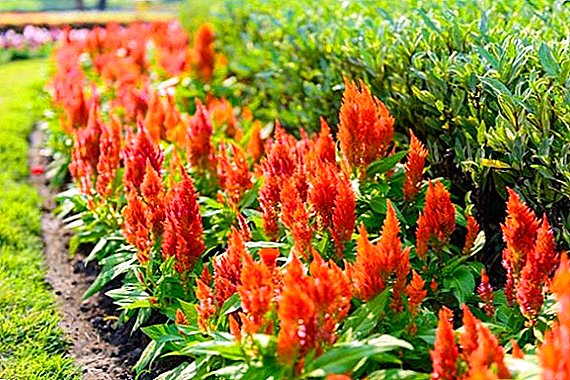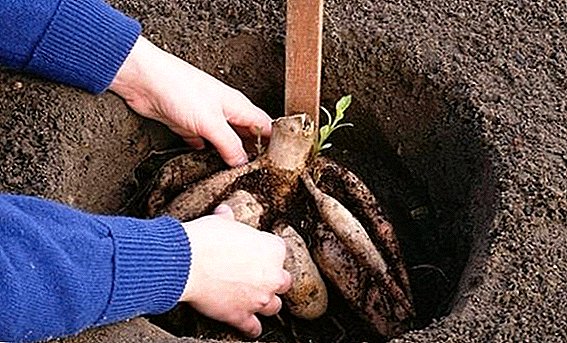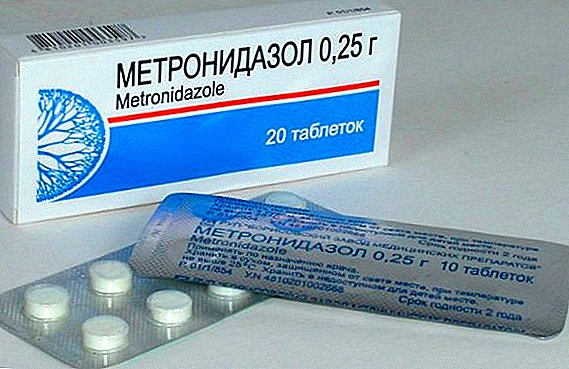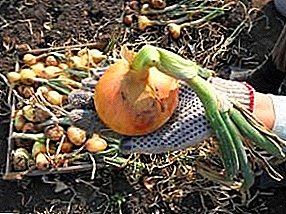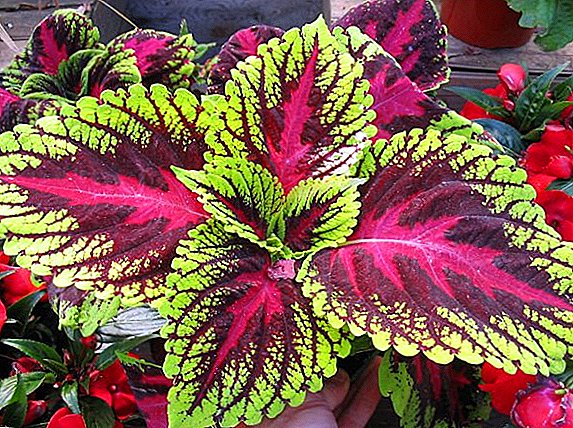 If you are still looking for a suitable sort of tomato for you, then by all means pay attention to the novelty from Siberian scientists - the universal hybrid "Pride of Siberia".
If you are still looking for a suitable sort of tomato for you, then by all means pay attention to the novelty from Siberian scientists - the universal hybrid "Pride of Siberia".
This is ideal for those farmers who intend to grow tomatoes in the greenhouse. Features varieties and care for him will consider the article.
Variety description
The Pride of Siberia is a determinant shtambov shrub. The plant is not too massive, in length it grows to a maximum of 1.5 meters. Culture is designed for cultivation mainly in protected land (that is, in the greenhouse). However, in areas with a favorable climate, it is possible to land in open ground.
A distinctive feature of the considered variety is large-fruited. In addition, the berries are distinguished by high commodity qualities.
Among the main advantages of this variety, growers note:
- early maturity;
- high yielding;
- excellent quality characteristics of the crop, including the pleasant taste of the fruit;
- disease resistance;
- suitability for transportation, storage.
Familiarize yourself with the cultivation of such determinant varieties of tomatoes as "Dwarf", "Gold Stream", "Red Banana", "Nastya", "Raspberry Giant", "Klusha", "Rio Fuego", "Riddle", "Stolypin", "Sanka", "Apparently-invisible", "Lazyka", "Bobkat", "Beginner", "Balcony miracle", "Chio-Chio-San".
Despite a number of advantages, the hybrid has its drawbacks. The plant has weak branches, they do not withstand the mass of fruits, often breaking or falling to the ground, and tomatoes rot from contact with the ground. To avoid breaking the bush, you have to spend a lot of time tying trunks or making props. In addition, such large tomatoes will not be able to pickle or pickle. 
Fruit characteristics and yield
"Pride of Siberia" is an early ripe variety, the first fruits can be removed approximately 85-110 days later after sprouting from the soil. With one square meter of land you can get about 20 kilograms of berries. The tomatoes themselves are large, weighing 750-900 g each.
Some samples can reach a kilogram. Tomatoes have a bright but harmonious taste (sweetish with light sourness). Ripe tomatoes are round in shape, slightly flattened from above, the largest samples are similar to pumpkin. The tomato has 6-7 seed chambers.
The flesh is odorous and juicy (dry matter in a tomato is about 6%), the skin is dense, they are painted in a bright raspberry-red color. As for the purpose of the variety, the fruits are perfect for fresh consumption, as ingredients for salads and for those dishes that require fresh tomatoes.
Did you know? The largest tomato in the world was grown in the US state of Wisconsin. Weighed fruit 2.9 pounds.From the fruits of the Siberian variety also get a good juice or pasta. However, for the preparation of home canned food, they are not suitable because of the large fruit.

Selection of seedlings
There are no particular differences in the breeding of the Pride of Siberia. Like other tomatoes, this species is grown with seedlings.
High-quality seedlings are selected from external data:
- Young bushes must be alive (not faded). For sale seedlings should be put up in containers with a substrate, and not in bags.
- The length of the bushes should not exceed 30 cm. Examine each plant so that there are about 8 true leaves on the trunk.
- Age of bushes should not exceed 45-60 days.
- The trunks should be thick, and the roots well developed and without noticeable damage.
- All leaves should be green, but it should not be too saturated tone. If the bright green leaves are also twisted inwards, this indicates that the method of accelerated cultivation was used (the seedlings were fed with abundant amounts of nitrogen fertilizers).
- Examine the sheet plastics for the presence of Colorado potato beetle eggs. There should not be any dark specks on the stem. Distorted and wrinkled leaves may indicate the defeat of the bushes infectious diseases.

Growing conditions
The tomato of the Siberian selection is a thermophilic plant. The optimum temperature for dilution is + 18-25 ° C. In addition to heat, plants need to be provided with good lighting. To grow tomatoes in the greenhouse allow LED energy-saving fitolampy. As for air humidity, the ideal indicator is 60-70%.
Tomatoes prefer loose, heated and nutritious soil. Shrubs respond positively to a soil rich in nitrogen and potassium. It will be useful to disinfect the soil, soaking it with potassium permanganate or copper sulfate solution. In addition, tomatoes love a slightly alkaline soil: a comfortable reaction is 6.5-7.0 pH (let's say the indicator is a bit higher).
Seed preparation and planting
Prepare the seeds for planting by pre-treating them with a solution of potassium permanganate or hot water. After that, germinate the seeds under a damp cloth in a warm place. Seedlings of greenhouse tomatoes begin to grow in late March.
Learn how to choose the optimal time for planting tomato seedlings, as well as how to germinate and plant tomato seeds.
It is at this time that the seeds must be sown in the soil. Spread them on the ground at a distance of a couple of centimeters and sprinkle with a dry substrate. Next, pour the soil with warm water. Cover the container with a film and store in a warm (+ 24-26 ° C) and protected from the sun place.
Video: preparing tomato seeds for planting With the advent of the first shoots, remove the shelter. Raise the seedlings on the table, providing it with light, moisture and heat (+ 20-24 ° C). When the tomatoes grow on two true leaves, plant bushes on individual containers. When transplanting, do not forget to dive the seedlings: so the root system will prepare for the upcoming transplant into the greenhouse, the bushes themselves will harden and get stronger.
Elongated plants must be fertilized. To do this, it is better to use special complex feeding, consisting of the required tomato seedlings of trace elements.
When the seedlings will be 40-45 days, begin to harden it. Transfer the pots first closer to the open windows, then onto a balcony or onto the street. The hardening time should be gradually increased - tomatoes should quickly adapt to the greenhouse climate.
Important! To plant a seedling, a greenhouse must be prepared in advance: replace the top layer of soil, wash the walls and all structures with a disinfectant. Airing is an important final stage of greenhouse preparation.
In stage 6-7 of these leaves you can transplant seedlings to a permanent place. Bushes preferably planted in rows. Given the large-fruited Siberian varieties, you should not place more than five seedling bushes per square meter of bed. The holes must be quite deep so that the rhizome can freely fit there.  The plant from the pot reach out gently, supporting the root with the earth hands. Dip the seedlings in the hole until the first set of leaves. Now you can fill it with substrate and press the ground with your hand. Around each bush make a small depression for watering. Immediately at the stage of planting seedlings near each bush, insert a peg, to which as the growth will bind the trunk.
The plant from the pot reach out gently, supporting the root with the earth hands. Dip the seedlings in the hole until the first set of leaves. Now you can fill it with substrate and press the ground with your hand. Around each bush make a small depression for watering. Immediately at the stage of planting seedlings near each bush, insert a peg, to which as the growth will bind the trunk.
Maintenance and care
The first two weeks do not irrigate the soil - the roots are not yet ready to take moisture, because the plant spends all its strength on adaptation. In the future, watering tomatoes of Siberian breeding is necessary often and abundantly. Use for irrigation always warm water.
Water the plants preferably in the morning (before the sun's rays become scorching). Do not forget about weeding: it is important to remove weeds, as they take away moisture, space and nutrients from cultivated plants.
We recommend reading about whether it is possible to grow tomatoes without watering, and also how to properly and how often water the tomatoes in the open field and greenhouse.
To maintain a tall plant, use pegs, tying the trunk to them at a height of about 15 cm. The bush should definitely be formed: it is advisable to grow a Siberian tomato in one or two stalks, otherwise the berries will be much smaller.  In addition, a quantitative indicator of the harvest will suffer significantly. Therefore, all the remaining shoots need to pinch until they grow more than 3 cm. Constantly monitor the condition of the plants and tie up fragile shoots, fruit brushes, stems.
In addition, a quantitative indicator of the harvest will suffer significantly. Therefore, all the remaining shoots need to pinch until they grow more than 3 cm. Constantly monitor the condition of the plants and tie up fragile shoots, fruit brushes, stems.
Mandatory in the care of tomato beds is feeding. Use rotted manure, bird droppings or mullein dissolved in water. Very useful mineral complexes. In the fruit formation phase, feed the plants with potassium and phosphorus - this will have a beneficial effect on the quality and taste of the tomatoes.
Disease and pest prevention
Reviews gardeners about the "Pride of Siberia" mostly positive. And although the hybrid is known for high resistance to pests and diseases, there are several problems that any farmer can face.
In order to prevent rot and late blight, systematically aerate the greenhouse. Do not allow overmoistening of air and accumulation of condensate on the greenhouse walls. Sometimes the berries can crack. The reason for this is intensive irrigation.
Important! Do not plant tomatoes next to potatoes - this minimizes the risk of wireworms.
To solve this unpleasant phenomenon, it is sufficient to reduce the frequency of irrigation and the amount of water used. Experts advise in addition to feed the plants with fertilizers, which contain saltpeter. In the hotbeds, the frequent guest of the Pride of Siberia is the common whitefly.  Carry out prevention against this dangerous parasite, using chemical agents, for example, "Confidor": mix 1 ml of the drug with 10 liters of water. The resulting composition process tomato bushes. This volume is enough for 100 square meters of the garden.
Carry out prevention against this dangerous parasite, using chemical agents, for example, "Confidor": mix 1 ml of the drug with 10 liters of water. The resulting composition process tomato bushes. This volume is enough for 100 square meters of the garden.
In the open garden bushes "Pride" can attack the wire. To get rid of the pest that has appeared, the following effective folk method is practiced: a few days before planting the tomatoes, traps are laid out in the form of potato halves buried on 10 cm before planting tomatoes.
It will be useful for you to read about how to deal with dangerous diseases and pests of tomatoes.
The larva smells the bait and goes on it. After 2-3 days, collect the traps and burn them together with pests, after which, if necessary, you can repeat the procedure.
Harvesting and Storage
Tomatoes of Siberian selection ripen early. For this reason, the berries are ripe when they turn red and become soft. Harvesting usually falls on July-September. In the summer greenhouse, where heating is not provided, the tomatoes begin to ripen around mid-July.
For the purpose of long-term storage, remove the fruit from the bush together with the stem. Harvest is well kept and undergoes transportation without any problems. It is necessary to store berries in a dry, dark and cool room (in the cellar or basement).  Arrange the tomatoes in wooden or plastic boxes. Try to fold the berries so that they do not touch each other. As you could see, the Pride of Siberia has a lot of advantages.
Arrange the tomatoes in wooden or plastic boxes. Try to fold the berries so that they do not touch each other. As you could see, the Pride of Siberia has a lot of advantages.
Did you know? Tomatoes for a long time were considered unfit for human consumption and even toxic. European gardeners raised them as outlandish ornamental plants. The French decorated the territory around arbors with tomato bushes, and the British were engaged in their cultivation in greenhouses. In the Dutch books of the XVI century, this plant is mentioned as an ornament of the gardens of Antwerp.Even a novice summer resident will be able to cope with the cultivation of the described variety. Tomatoes will delight you with their unpretentiousness, abundant harvest and excellent taste.





